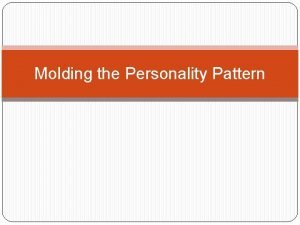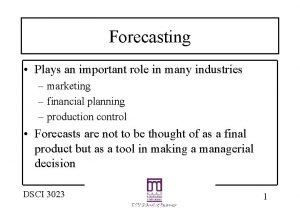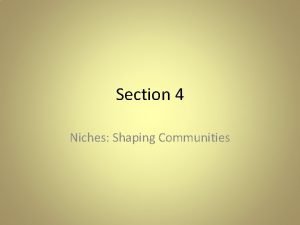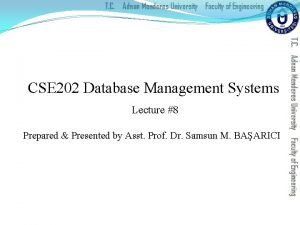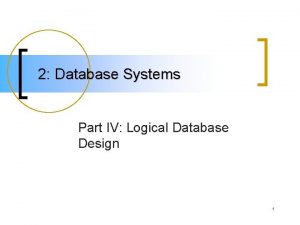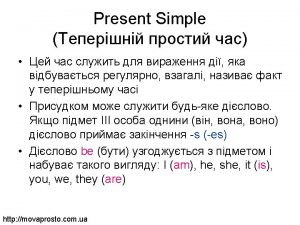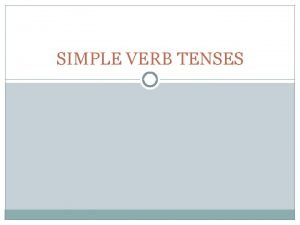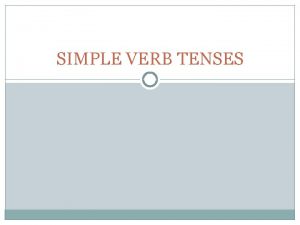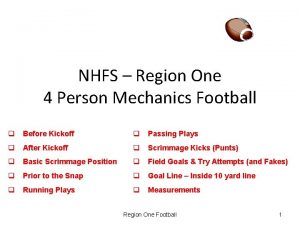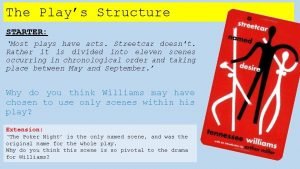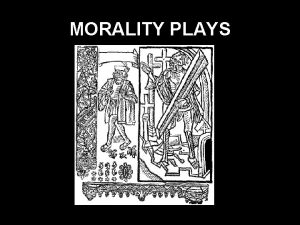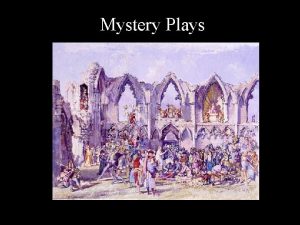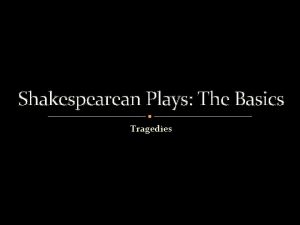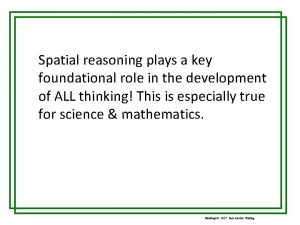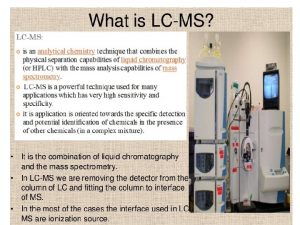Search Search plays a key role in many





















 is in fact: problem. Successor-Fn(node. State) or problem. get. Successor. Some pseudocode interpretations Successor-Fn[problem](State[node]) is in fact: problem. Successor-Fn(node. State) or problem. get. Successor.](https://slidetodoc.com/presentation_image/2aef536c987e299ce846ff1daf63700f/image-22.jpg)




































- Slides: 58

Search • Search plays a key role in many parts of AI. These algorithms provide the conceptual backbone of almost every approach to the systematic exploration of alternatives. • There are four classes of search algorithms, which differ along two dimensions: – First, is the difference between uninformed (also known as blind) search and then informed (also known as heuristic) searches. • Informed searches have access to task-specific information that can be used to make the search process more efficient. – The other difference is between any solution searches and optimal searches. • Optimal searches are looking for the best possible solution while anypath searches will just settle for finding some solution.

Graphs • Graphs are everywhere; E. g. , think about road networks or airline routes or computer networks. • In all of these cases we might be interested in finding a path through the graph that satisfies some property. • It may be that any path will do or we may be interested in a path having the fewest "hops" or a least cost path assuming the hops are not all equivalent.

Romania graph

Formulating the problem • On holiday in Romania; currently in Arad. • Flight leaves tomorrow from Bucharest. • Formulate goal: – be in Bucharest • Formulate problem: – states: various cities – actions: drive between cities • Find solution: – sequence of cities, e. g. , Arad, Sibiu, Fagaras, Bucharest

Another graph example • However, graphs can also be much more abstract. • A path through such a graph (from a start node to a goal node) is a "plan of action" to achieve some desired goal state from some known starting state. • It is this type of graph that is of more general interest in AI.

Problem solving • One general approach to problem solving in AI is to reduce the problem to be solved to one of searching a graph. • To use this approach, we must specify what are the states, the actions and the goal test. • A state is supposed to be complete, that is, to represent all the relevant aspects of the problem to be solved. • We are assuming that the actions are deterministic, that is, we know exactly the state after the action is performed.

Goal test • In general, we need a test for the goal, not just one specific goal state. – So, for example, we might be interested in any city in Germany rather than specifically Frankfurt. • Or, when proving a theorem, all we care is about knowing one fact in our current data base of facts. – Any final set of facts that contains the desired fact is a proof.

Vacuum cleaner?

Vacuum cleaner

Vacuum cleaner

Formally… A problem is defined by four items: 1. 2. initial state e. g. , "at Arad" actions and successor function S: = set of action-state tuples – e. g. , S(Arad) = {(go. Zerind, Zerind), (go. Timisoara, Timisoara), (go. Silbiu, Silbiu)} 3. goal test, can be – explicit, e. g. , x = "at Bucharest" – implicit, e. g. , Checkmate(x) 4. path cost (additive) – e. g. , sum of distances, or number of actions executed, etc. – c(x, a, y) is the step cost, assumed to be ≥ 0 • A solution is a sequence of actions leading from the initial state to a goal state

Example: The 8 -puzzle • • states? actions? goal test? path cost?

Example: The 8 -puzzle • • states? locations of tiles actions? move blank left, right, up, down goal test? = goal state (given) path cost? 1 per move

Romania graph

Tree search example

Tree search example

Tree search example

Tree search algorithms • Basic idea: – Exploration of state space by generating successors of already-explored states (i. e. expanding states)

Implementation: states vs. nodes • A state is a (representation of) a physical configuration • A node is a bookeeping data structure constituting of state, parent node, action, path cost g(x), depth • The Expand function creates new nodes, filling in the various fields and using the Successor. Fn of the problem to create the corresponding states.

The fringe • The collection of nodes that have been generated but not yet expanded is called fringe. (outlined in bold) • We will implement collection of nodes as queues. The operations on a queue are as follows: • Empty? (queue) check to see whether the queue is empty • First(queue) returns the first element • Remove-First(queue) returns the first element and then removes it • Insert(element, queue) inserts an element into the queue and returns the resulting queue • Insert. All(elements, queue) inserts a set of elements into the queue and returns the resulting queue

Implementation public class Problem { Object initial. State; Successor. Function successor. Function; Goal. Test goal. Test; Step. Cost. Function step. Cost. Function; Heuristic. Function heuristic. Function; …
 is in fact: problem. Successor-Fn(node. State) or problem. get. Successor.](https://slidetodoc.com/presentation_image/2aef536c987e299ce846ff1daf63700f/image-22.jpg)
Some pseudocode interpretations Successor-Fn[problem](State[node]) is in fact: problem. Successor-Fn(node. State) or problem. get. Successor. Function(). get. Successors( node. get. State() );

Implementation: general tree search The queue policy of the fringe embodies the strategy.

Search strategies • A search strategy is defined by picking the order of node expansion • Strategies are evaluated along the following dimensions: – completeness: does it always find a solution if one exists? – time complexity: number of nodes generated – space complexity: maximum number of nodes in memory – optimality: does it always find a least-cost solution? • Time and space complexity are measured in terms of – b: maximum branching factor of the search tree – d: depth of the least-cost solution – m: maximum depth of the state space

Uninformed search strategies • Uninformed do not use information relevant to the specific problem. • • • Breadth-first search Uniform-cost search Depth-first search Depth-limited search Iterative deepening search

Breadth-first search • Tree. Search(problem, FIFO-QUEUE()) results in a breadth-first search. • The FIFO queue puts all newly generated successors at the end of the queue, which means that shallow nodes are expanded before deeper nodes. – I. e. Pick from the fringe to expand the shallowest unexpanded node

Breadth-first search • Expand shallowest unexpanded node • Implementation: – fringe is a FIFO queue, i. e. , new successors go at end

Breadth-first search • Expand shallowest unexpanded node • Implementation: – fringe is a FIFO queue, i. e. , new successors go at end

Breadth-first search • Expand shallowest unexpanded node • Implementation: – fringe is a FIFO queue, i. e. , new successors go at end

Properties of breadth-first search • Complete? – Yes (if b is finite) • Time? – 1+b+b 2+b 3+… +bd + b(bd-1) = O(bd+1) • Space? – O(bd+1) (keeps every node in memory) • Optimal? – Yes (if cost is a non-decreasing function of depth, e. g. when we have 1 cost per step)

Suppose b=10, 000 nodes/sec, 1000 bytes/node Depth Nodes Time Memory 2 1100 . 11 sec 1 Megabyte 4 111, 100 11 sec 106 Megabyte 6 107 19 min 10 Gigabyte 8 109 31 hours 1 Terabyte 10 1011 129 days 101 Terabyte 12 1013 35 years 10 Petabyte 14 1015 3, 523 1 Exabyte

Uniform-cost search • • • Expand least-cost unexpanded node. The algorithm expands nodes in order of increasing path cost. Therefore, the first goal node selected for expansion is the optimal solution. • Implementation: – fringe = queue ordered by path cost (priority queue) • Equivalent to breadth-first if step costs all equal • Complete? Yes, if step cost ≥ ε (I. e. not zero) • Time? number of nodes with g ≤ cost of optimal solution, O(b. C*/ ε) where C* is the cost of the optimal solution • Space? Number of nodes with g ≤ cost of optimal solution, O(b. C*/ ε) • Optimal? Yes – nodes expanded in increasing order of g(n)

Try it here

Depth-first search • Expand deepest unexpanded node • Implementation: – fringe = LIFO queue, i. e. , put successors at front

Depth-first search • Expand deepest unexpanded node • Implementation: – fringe = LIFO queue, i. e. , put successors at front

Depth-first search • Expand deepest unexpanded node • Implementation: – fringe = LIFO queue, i. e. , put successors at front

Depth-first search • Expand deepest unexpanded node • Implementation: – fringe = LIFO queue, i. e. , put successors at front

Depth-first search • Expand deepest unexpanded node • Implementation: – fringe = LIFO queue, i. e. , put successors at front

Depth-first search • Expand deepest unexpanded node • Implementation: – fringe = LIFO queue, i. e. , put successors at front

Depth-first search • Expand deepest unexpanded node • Implementation: – fringe = LIFO queue, i. e. , put successors at front

Depth-first search • Expand deepest unexpanded node • Implementation: – fringe = LIFO queue, i. e. , put successors at front

Depth-first search • Expand deepest unexpanded node • Implementation: – fringe = LIFO queue, i. e. , put successors at front

Depth-first search • Expand deepest unexpanded node • Implementation: – fringe = LIFO queue, i. e. , put successors at front

Depth-first search • Expand deepest unexpanded node • Implementation: – fringe = LIFO queue, i. e. , put successors at front

Depth-first search • Expand deepest unexpanded node • Implementation: – fringe = LIFO queue, i. e. , put successors at front

Properties of depth-first search • Complete? No: fails in infinite-depth spaces, spaces with loops – Modify to avoid repeated states along path complete in finite spaces • Time? O(bm): terrible if m is much larger than d – but if solutions are dense, may be much faster than breadth-first • Space? O(bm), i. e. , linear space! • Optimal? No

Depth-limited search Depth. Limited. Search (int limit) { stack. ADT fringe; insert root into the fringe do { if (Empty(fringe)) return NULL; /* Failure */ node. PT = Pop(fringe); if (Goal. Test(node. PT->state)) return node. PT; /* Expand node and insert all the successors */ if (node. PT->depth < limit) { insert into the fringe Expand(node. PT) } while (1); }

Iterative deepening search Iterative. Deepening. Search () { for (int depth=0; ; depth++) { node=Depth. Limitedt. Search(depth); if ( node != NULL ) return node; } }

Iterative deepening search l =0

Iterative deepening search l =1

Iterative deepening search l =2

Iterative deepening search l =3

Iterative deepening search • Number of nodes generated in a depth-limited search to depth d with branching factor b: NDLS = b 0 + b 1 + b 2 + … + bd-2 + bd-1 + bd • Number of nodes generated in an iterative deepening search to depth d with branching factor b: NIDS = (d+1)b 0 + d b 1 + (d-1)b 2 + … + 3 bd-2 +2 bd-1 + 1 bd • For b = 10, d = 5, – NDLS = 1 + 100 + 1, 000 + 100, 000 = 111, 111 – NIDS = 6 + 50 + 400 + 3, 000 + 20, 000 + 100, 000 = 123, 456 • Overhead = (123, 456 - 111, 111)/111, 111 = 11%

• • Properties of iterative deepening search Complete? Yes Time? (d+1)b 0 + d b 1 + (d-1)b 2 + … + bd = O(bd) Space? O(bd) Optimal? Yes, if step cost = 1

Summary of algorithms

Repeated states • Failure to detect repeated states can turn a linear problem into an exponential one!

Graph search

Class problem • You have three jugs, measuring 12 gallons, 8 gallons, and 3 gallons, and a water faucet. • You can fill the jugs up, or empty them out from one another or onto the ground. • You need to measure out exactly one gallon.
 Mystery plays miracle plays morality plays
Mystery plays miracle plays morality plays Molding personality meaning
Molding personality meaning Deca role play examples
Deca role play examples Deca role play examples
Deca role play examples Communication plays a very important role in
Communication plays a very important role in Forecasting plays an important role in
Forecasting plays an important role in Dignity its essential role in resolving conflict
Dignity its essential role in resolving conflict Learning activity examples
Learning activity examples Describe the role competition plays in shaping communities.
Describe the role competition plays in shaping communities. Importance of paralanguage
Importance of paralanguage Azure web role vs worker role
Azure web role vs worker role Role making role taking beispiele
Role making role taking beispiele Statuses and their related roles determine the structure
Statuses and their related roles determine the structure Key partners key activities key resources
Key partners key activities key resources Key partners key activities key resources
Key partners key activities key resources Many buyers and sellers
Many buyers and sellers Er model
Er model Unary many to many
Unary many to many Erm and erd
Erm and erd Unary many to many
Unary many to many Contoh erd many to many
Contoh erd many to many Unary many to many
Unary many to many Many to many communication
Many to many communication Sqlbi many to many
Sqlbi many to many Unary relationship database
Unary relationship database Many sellers and many buyers
Many sellers and many buyers Characteristics of a relational database
Characteristics of a relational database Three types of shakespeare plays
Three types of shakespeare plays Wildcat football plays
Wildcat football plays Morality plays in english literature
Morality plays in english literature Three types of shakespeare plays
Three types of shakespeare plays Shakespeare character types
Shakespeare character types How to cite a shakespeare play
How to cite a shakespeare play They play football present simple
They play football present simple One act plays definition
One act plays definition Morality plays characteristics
Morality plays characteristics Examples of liturgical drama
Examples of liturgical drama Greek plays grew out of
Greek plays grew out of Flexbone offense plays
Flexbone offense plays The well made play structure
The well made play structure Power i formation plays
Power i formation plays Naturalism drama definition
Naturalism drama definition Ancient rome theater
Ancient rome theater Ancient greek theatre diagram
Ancient greek theatre diagram The plays the thing
The plays the thing Past perfect tense of wake up
Past perfect tense of wake up Sorry, i ______ hear you at the door.
Sorry, i ______ hear you at the door. Romantic theater
Romantic theater Short radio plays
Short radio plays Elizabethan tragedies were modeled on plays from
Elizabethan tragedies were modeled on plays from Johann wolfgang von goethe plays
Johann wolfgang von goethe plays Conventions in theatre
Conventions in theatre Adverb of play
Adverb of play Plays adverb
Plays adverb Plays like romeo and juliet
Plays like romeo and juliet Italian renaissance theater
Italian renaissance theater Elements of radio play
Elements of radio play Famous radio plays
Famous radio plays Fbz service plays
Fbz service plays

